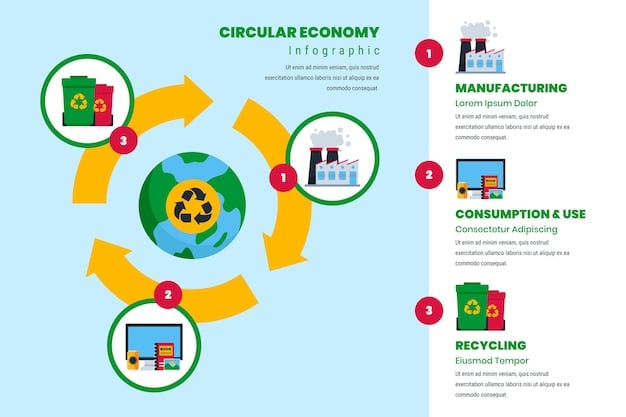How US Businesses Can Cut Carbon Footprint by 25% in 5 Years

US businesses can reduce their carbon footprint by 25% in the next five years by implementing strategies such as investing in renewable energy, improving energy efficiency, adopting sustainable supply chains, reducing waste, and embracing remote work options.
Interested in learning how can US businesses reduce their carbon footprint by 25% in the next 5 years? It’s a challenge, but with a focused approach, American companies can significantly minimize environmental impact and contribute to a sustainable future.
Understanding the Urgency of Carbon Footprint Reduction
Reducing carbon footprint is no longer just a trendy topic; it’s an urgent imperative for businesses worldwide, particularly in the US. Climate change is accelerating, and companies have a crucial role to play in mitigating its effects. Doing so offers not only environmental benefits but also significant economic opportunities.
The Current State of US Business Emissions
US businesses contribute significantly to the nation’s overall carbon emissions. Understanding where these emissions come from—whether it’s manufacturing, transportation, or energy consumption—is the first step towards creating effective reduction strategies.
Why 25% in 5 Years?
Setting a target like a 25% reduction in carbon footprint within five years provides a tangible, achievable goal. This timeframe allows for strategic planning, investment in new technologies, and gradual implementation of sustainable practices without disrupting business operations.
- Environmental Concerns: Reducing emissions helps to combat climate change, preserving natural resources and ecosystems.
- Economic Benefits: Efficiency improvements and sustainable practices can lead to cost savings and new market opportunities.
- Social Responsibility: Demonstrating commitment to sustainability enhances a company’s reputation and attracts environmentally conscious customers and employees.
By acknowledging the urgency and setting clear objectives, US businesses can drive meaningful change in their carbon footprint, contributing to a healthier planet and a more sustainable economy.
Investing in Renewable Energy Sources
One of the most impactful steps US businesses can take to reduce their carbon footprint is transitioning to renewable energy sources. This shift can significantly decrease reliance on fossil fuels and lower overall emissions. Solar, wind, and geothermal energy are viable options.
Solar Power Adoption
Installing solar panels on commercial buildings allows businesses to generate their own clean electricity. Government incentives and declining solar panel costs make this an increasingly attractive option.
Wind Energy Solutions
For businesses with larger land areas, investing in small-scale wind turbines can provide a sustainable energy source. Wind energy can be particularly effective in rural areas with consistent wind patterns.

- Government Incentives: Take advantage of federal and state tax credits, grants, and rebates for renewable energy installations.
- Power Purchase Agreements (PPAs): Enter into agreements with renewable energy providers to purchase clean energy at a fixed rate.
- Community Solar Programs: Participate in community solar projects to access solar energy without installing panels on your property.
By embracing renewable energy, businesses not only reduce their carbon footprint but also gain greater energy independence and potentially lower long-term energy costs.
Improving Energy Efficiency in Operations
Enhancing energy efficiency across all business operations is a critical strategy. By identifying and addressing areas of energy waste, companies can significantly reduce their carbon footprint and realize cost savings. Conducting energy audits is a great first step.
Energy Audits and Assessments
Regular energy audits help identify inefficiencies in buildings, equipment, and processes. These audits provide actionable recommendations for improvement, such as upgrading to energy-efficient lighting, HVAC systems, and insulation.
Optimizing HVAC Systems
Heating, ventilation, and air conditioning (HVAC) systems are major energy consumers. Upgrading to modern, energy-efficient HVAC units and implementing smart controls can significantly reduce energy usage.
Adopting energy-efficient practices and technologies offers immediate and long-term benefits, contributing to a more sustainable business model and a reduced environmental impact.
Adopting Sustainable Supply Chain Management
A company’s supply chain often accounts for a significant portion of its carbon emissions. Adopting sustainable supply chain management practices involves evaluating and reducing environmental impact across all stages, from raw material sourcing to product distribution.

Evaluating Supplier Sustainability
Assess the environmental practices of suppliers and prioritize those committed to reducing their carbon footprint. This can involve choosing suppliers with eco-friendly manufacturing processes, sustainable sourcing, and efficient transportation methods.
Optimizing Transportation and Logistics
Streamline transportation routes, consolidate shipments, and use fuel-efficient vehicles to reduce emissions from logistics. Consider using alternative transportation methods like rail or electric vehicles where possible.
- Life Cycle Assessments (LCAs): Conduct LCAs to understand the environmental impact of products throughout their entire life cycle, from raw material extraction to disposal.
- Collaboration and Partnerships: Work with suppliers and stakeholders to develop joint sustainability initiatives and share best practices.
- Certification Programs: Seek certifications such as ISO 14001 to demonstrate commitment to environmental management.
Creating a sustainable supply chain requires commitment and collaboration, but it yields significant environmental and reputational benefits, fostering a culture of sustainability within the business ecosystem.
Reducing Waste and Promoting Circular Economy
Waste reduction is a pivotal aspect of lowering carbon footprint. Implementing strategies that minimize waste generation, promote recycling, and embrace circular economy principles can lead to substantial emission reductions and cost savings. Waste reduction is a great way to lower carbon emissions.
Implementing Recycling Programs
Establish comprehensive recycling programs within the workplace to ensure materials like paper, plastic, and glass are properly recycled. Provide clearly labeled recycling bins and educate employees about proper recycling practices.
Reducing Food Waste
For businesses in the food industry, reducing food waste is crucial. Implement strategies to minimize waste during food preparation, storage, and serving. Donate surplus food to local charities or food banks.
By reducing waste and embracing circular economy principles, businesses can conserve resources, lower emissions, and contribute to a more sustainable and resilient economy.
Embracing Remote Work and Reducing Commuting
Enabling remote work options can significantly reduce carbon emissions associated with employee commuting. By reducing the number of employees driving to the office, businesses can lower their carbon footprint and improve employee satisfaction.
Supporting Remote Work Policies
Implement flexible remote work policies that allow employees to work from home or satellite offices. Provide the necessary technology and support to ensure remote employees remain productive and engaged.
Encouraging Virtual Meetings
Promote the use of virtual meeting platforms to reduce the need for business travel. Virtual meetings can save time, reduce travel costs, and significantly lower carbon emissions.
- Carbon Footprint Tracking: Monitor and track the carbon emissions associated with employee commuting and business travel to measure the impact of remote work initiatives.
- Incentivizing Sustainable Transportation: Encourage employees to use public transportation, cycling, or walking by providing incentives such as transportation allowances or bike-sharing programs.
- Telecommuting Tools: Invest in robust telecommuting tools and infrastructure to ensure seamless remote collaboration and communication.
By embracing remote work and reducing commuting, businesses can contribute to cleaner air, reduced traffic congestion, and a more sustainable future for their employees and communities.
| Key Point | Brief Description |
|---|---|
| ☀️ Renewable Energy | Invest in solar, wind, and geothermal energy to reduce reliance on fossil fuels. |
| ⚡ Energy Efficiency | Improve HVAC, lighting, and equipment to minimize energy consumption. |
| ♻️ Waste Reduction | Implement recycling programs and reduce food waste to conserve resources. |
| 🏠 Remote Work | Encourage remote work to decrease commuting-related emissions. |
Frequently Asked Questions
▼
A carbon footprint is the total greenhouse gas emissions caused by an individual, organization, event, or product. It is typically measured in units of carbon dioxide equivalent.
▼
Reducing carbon footprint helps mitigate climate change, comply with regulations, improve brand reputation, attract customers, and reduce operational costs through energy efficiency.
▼
Businesses can measure their carbon footprint by conducting a carbon audit, using carbon footprint calculators, or hiring environmental consultants to assess their emissions across various activities.
▼
Quick wins include switching to LED lighting, implementing energy-efficient appliances, reducing paper usage, encouraging remote work, and optimizing heating and cooling systems.
▼
Technology can aid in reducing emissions through smart energy management systems, cloud computing, virtual meetings, efficient transportation logistics, and renewable energy monitoring solutions.
Conclusion
Reducing the carbon footprint of US businesses by 25% in the next five years is an ambitious yet achievable goal. By adopting renewable energy, improving energy efficiency, implementing sustainable supply chains, reducing waste, and embracing remote work, companies can make significant progress towards a more sustainable future. The journey requires commitment, innovation, and collaboration, but the benefits for the environment, economy, and society are immense.





